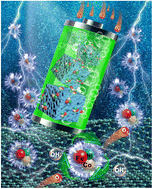Atomic-level orbital coupling in a tri-metal alloy site enables highly efficient reversible oxygen electrocatalysis†
Abstract
Complex multi-metallic alloys with ultra-small sizes have received extensive attention in the fields of Zn–air battery and water splitting, because of their unique advantages including adjustable composition, tailorable active sites, and optimizable electronic structure. In this effort, an atomic-level orbital coupling strategy is presented to effectively regulate the electronic structures of ultra-small tri-metal Fe–Co–Ni nanoalloy particles confined in an N-doped carbon hollow nanobox. As expected, the optimal nanoalloy hybrid material exhibited notable bi-functional catalytic performances toward the oxygen reduction reaction (half-wave potential of 0.902 V) and oxygen evolution reaction (1.589 V at 10 mA cm−2) with a small ΔE of 0.687 V, exceeding the precious-metal-based and many previously reported catalysts. Furthermore, the as-assembled Zn–air device also displayed a superior specific capacity of 894 mA h g−1, a maximal power density of 247 mW cm−2, and impressive durability (over 100 hours). Ultraviolet photoelectron spectroscopy and density functional theory calculations revealed that the electronic structures could be finely tuned and optimized through ternary metal alloying, resulting in a suitable d-band center and advantageous interfacial charge-transfer, which in turn could effectively reduce the involved energy barriers in the electrocatalytic process and significantly boost its intrinsic activity of reversible oxygen catalysis. Thus, this work affords an effective method for the rational creation of bi-functional non-noble-metal-based electrocatalysts for sustainable energy technology.

- This article is part of the themed collection: Journal of Materials Chemistry A HOT Papers


 Please wait while we load your content...
Please wait while we load your content...